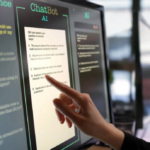In a world dominated by technological advancements and the ever-evolving landscape of artificial intelligence, the fear of job displacement is palpable. However, certain careers remain resistant to the digital wave, standing tall as future-proof options for individuals seeking job security and fulfillment.
Let’s dive into creativity, emotional intelligence, complex problem-solving, technical expertise, and the human touch to identify careers AI can’t replace in the foreseeable future.
Impact of AI on the Job Market
Recently, AI, or artificial intelligence, has become a buzzword, and its presence is making waves in the job market. This technological marvel is like a digital assistant, learning and performing tasks without a coffee break.
Routine jobs that involve doing the same thing repeatedly might feel the impact. Think about jobs where you do something in a set pattern, like sorting files or answering the same questions every day. AI can swoop in and do these tasks faster and without getting tired. But don’t panic just yet! While some jobs might shift, new opportunities sprout up, like fresh flowers after rain.
Some jobs may evolve, with AI becoming a helpful sidekick rather than a replacement. For example, AI can assist doctors by analyzing data, but the heart-touching care and empathy you get from a human nurse? AI struggles there.
Jobs that AI Can’t Replace
As AI advances, routine tasks become automated, leading to concerns about job displacement. However, this transformation also creates opportunities for individuals to focus on uniquely human attributes that AI struggles to replicate.
Some jobs that AI can’t replace are:
Content Creation
In the vast landscape of the digital world, content creation stands as a beacon of human ingenuity, resistant to the encroachment of artificial intelligence (AI). This job involves crafting words and visuals that captivate, inform, and entertain—an endeavor where the human touch remains unparalleled.
One key aspect of content creation is creativity, a uniquely human trait AI struggles to emulate. Creativity is the spark that ignites fresh ideas and innovative concepts, allowing content creators to breathe life into stories, articles, and multimedia. AI, despite its prowess, lacks the intuitive understanding and imaginative flair essential for producing engaging and relatable content.
Content creation often requires a deep understanding of context, including current events, cultural references, and social dynamics. Humans possess an innate ability to grasp context, adapting their content to resonate with specific audiences in real time. This emotional resonance is a cornerstone of content that resonates with individuals, a realm where AI’s algorithms fall short.
Additionally, content creation often involves adapting to evolving trends and cultural shifts—a dynamic landscape where human intuition and contextual awareness shine. Content creators possess the flexibility to respond to changing preferences and societal nuances, tailoring their output to connect with diverse audiences.
Graphic Designing
Within the realm of creative professions, graphic designing stands as a testament to the distinctive capabilities of human ingenuity. In this field, individuals harness their artistic prowess to convey messages visually, an artistry that eludes the grasp of artificial intelligence (AI).
The essence of graphic design lies in the ability to seamlessly blend aesthetics and functionality—a delicate balance that requires an understanding of human sensibilities. AI, despite its computational prowess, struggles to interpret the nuanced preferences and subjective perceptions that define visual appeal.
Creativity, a cornerstone of graphic design, remains a uniquely human quality. Graphic designers infuse meaning and emotion into visuals, telling stories through color, form, and composition. The intuitive understanding of how design elements evoke specific responses in viewers is where human designers excel, steering clear of the rigid algorithms guiding AI.
Design projects often require a personalized touch to cater to specific client needs or target audiences. Human designers excel at tailoring designs to meet individual requirements, considering factors like brand identity and user preferences. AI may struggle to achieve the customization and personalization that human designers can provide.
Marketing Strategist
Marketing strategy involves a nuanced understanding of human behavior, cultural nuances, and market trends—dimensions that rely on the empathetic and intuitive qualities intrinsic to human strategists. While AI excels at processing data, the interpretative finesse required to discern the subtle shifts in consumer sentiment and preferences eludes its capabilities.
The craft of a marketing strategist extends beyond the numerical realm, encompassing the ability to weave narratives that resonate with diverse audiences. The strategic decisions involved in positioning a product or service, tailoring messaging to evoke specific emotions, and anticipating consumer responses demand a level of emotional intelligence and creativity that AI struggles to replicate.
Moreover, the dynamic nature of the marketing landscape necessitates adaptability—a quality deeply ingrained in human strategists. The ability to pivot strategies in response to evolving market conditions, emerging trends, and unforeseen challenges relies on a blend of experience, intuition, and strategic foresight that AI, in its algorithmic rigidity, finds challenging.
Data Analyst
In data analysis, the role of a data analyst remains firmly rooted in the capabilities of human intuition and analytical finesse, elements that elude the complete replication by artificial intelligence.
Data analysts play a pivotal role in not just processing vast datasets but also in interpreting the insights derived from them. While AI can handle the computational aspects efficiently, the nuanced understanding required to draw meaningful conclusions and implement strategic decisions remains a distinctly human trait.
Moreover, the contextual interpretation of data involves an intricate dance of understanding industry specifics, business objectives, and the broader socio-economic landscape. Data analysts bring industry knowledge and business acumen that transcends raw data processing, making them indispensable in providing actionable recommendations tailored to the unique needs of organizations.
The human touch extends to the communication of findings. Data analysts bridge the gap between complex data sets and non-technical stakeholders, translating insights into a language decision-makers can comprehend. The ability to convey the significance of data-driven insights with clarity and relevance is a skill beyond AI’s capabilities.
Research and Development
AI is proficient at solving well-defined problems with clear inputs and outputs. However, complex problem-solving in ambiguous and dynamic environments is a human strength. R&D frequently deals with intricate challenges where the path to a solution is not straightforward.
The crux of R&D is pursuing novel solutions and advancements, a process deeply rooted in human curiosity and creativity. While AI excels at processing existing data, the generation of innovative ideas and the ability to think beyond established patterns remain distinctive human attributes. R&D professionals bring a level of imagination and critical thinking that goes beyond the algorithmic capabilities of AI.
Furthermore, it involves not only creativity but also the practical application of these ideas to create tangible progress. This requires a blend of theoretical knowledge and hands-on expertise, which forms the essence of human involvement in the research process. The synergy within a team, with individuals complementing each other’s strengths, is a unique aspect that AI struggles to replicate.
Cybersecurity
Cyber threats are dynamic and continually evolving. Human cybersecurity professionals can adapt swiftly to novel attack vectors and craft innovative defense strategies. AI, while powerful, may struggle to keep pace with the creativity and adaptability inherent in human problem-solving.
This critical job stands resilient against complete replacement by artificial intelligence (AI), as it encompasses a range of skills deeply rooted in human intuition and strategic thinking.
Cybersecurity involves not only the implementation of protective measures but also a continuous assessment of potential risks and vulnerabilities. Human cybersecurity experts possess the ability to think critically and proactively identify potential threats, a facet of the job that extends beyond the algorithmic capabilities of AI.
Moreover, the adaptability required in cybersecurity is a distinctly human trait. The ability to navigate and respond to ever-changing cyber threats, understand new attack vectors and devise countermeasures demands a level of dynamic problem-solving that transcends the capabilities of automated systems.
Additionally, the ethical considerations inherent in cybersecurity decision-making require a human touch. Professionals in this field make judgment calls based on a complex understanding of not just technical aspects but also legal and ethical implications. The contextual awareness and ethical decision-making involved in cybersecurity highlight the indispensable role of human expertise.
Robotics Engineer
In the intricate field of robotics, the role of a robotics engineer emerges as a pivotal force driving technological advancement. This profession remains steadfast against complete replacement by artificial intelligence (AI), owing to the uniquely human qualities and skills essential to the field.
Robotics engineers play a crucial role in the design, development, and maintenance of robots, which demands a combination of technical expertise and creative problem-solving. The ability to innovate and think beyond established norms is a distinctly human trait that remains at the core of successful robotics engineering.
Moreover, the practical application of robotics involves addressing real-world challenges that extend beyond the capabilities of AI. Robotics engineers navigate complexities in physical environments, ensuring that robots operate seamlessly in diverse settings. The adaptability to unforeseen circumstances and the hands-on nature of the work highlight the indispensable role of human engineers in robotics.
Quantum Computing Experts
Within the cutting-edge era of quantum computing, the role of a quantum computing expert stands as a beacon of human expertise and innovation. This specialized profession remains impervious to complete replacement by artificial intelligence (AI), as it entails a unique blend of theoretical understanding, practical application, and human ingenuity.
The practical implementation of quantum computing involves delicate manipulation of quantum bits or qubits. Quantum computing experts possess a hands-on understanding of the hardware, overcoming challenges posed by the inherently unpredictable nature of quantum systems. This intricate interplay of theory and application is where human intuition and adaptability shine.
Conclusion:
In this job market, the resilience of these professions lies in the innate human abilities of creativity, adaptability, and collaborative problem-solving. As we traverse the digital frontier, embracing the future-proof careers that AI can’t replace ensures not only job security but also the preservation of the human element in diverse fields.
For individuals seeking to embark on these future-proof career paths, the iApply platform emerges as a comprehensive solution. iApply is a centralized hub offering a streamlined approach to job searching across diverse sectors.









